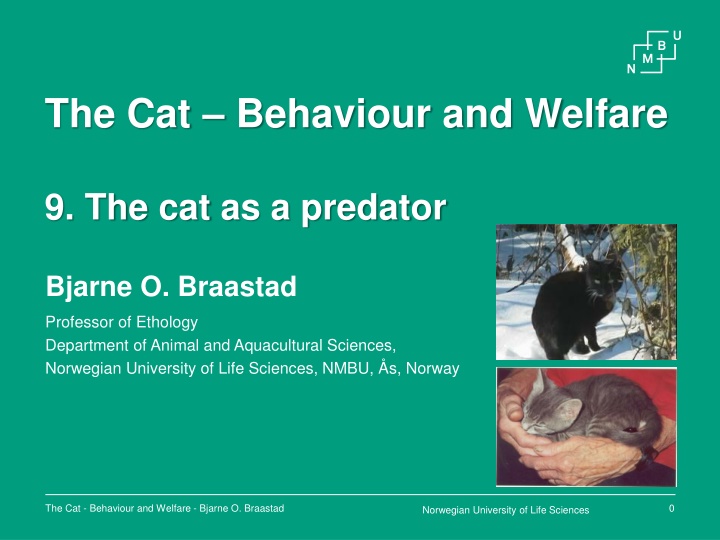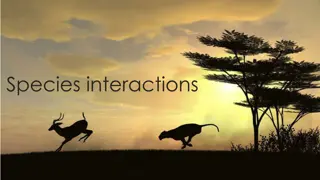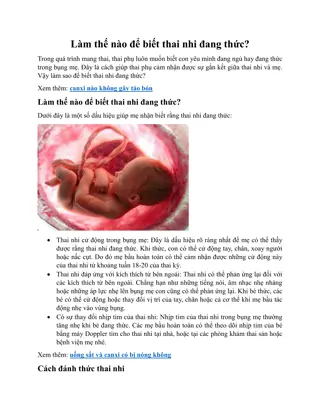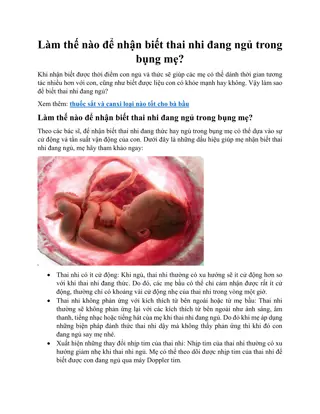
Cat Predatory Behavior and Hunting Efficiency Insights
Explore the intriguing world of the cat as a predator, delving into its hunting behavior, prey species, and hunting efficiency. Learn about the sequence of hunting behavior, the role of play in predatory activities, and the common prey species targeted by cats. Understand the factors influencing a cat's hunting motivation and the significance of predatory play in both behavioral development and adult cats. Gain valuable insights into the hunting prowess of felines and how their hunting efficiency changes with age.
Download Presentation

Please find below an Image/Link to download the presentation.
The content on the website is provided AS IS for your information and personal use only. It may not be sold, licensed, or shared on other websites without obtaining consent from the author. If you encounter any issues during the download, it is possible that the publisher has removed the file from their server.
You are allowed to download the files provided on this website for personal or commercial use, subject to the condition that they are used lawfully. All files are the property of their respective owners.
The content on the website is provided AS IS for your information and personal use only. It may not be sold, licensed, or shared on other websites without obtaining consent from the author.
E N D
Presentation Transcript
The Cat Behaviour and Welfare 9. The cat as a predator Bjarne O. Braastad Professor of Ethology Department of Animal and Aquacultural Sciences, Norwegian University of Life Sciences, NMBU, s, Norway The Cat - Behaviour and Welfare - Bjarne O. Braastad 0 Norwegian University of Life Sciences
Predatory behaviour the cat as a predator, a threat to populations of small birds?
Hunting behaviour of cats a long sequence of behaviour Hunting motivation seek a hunting place Relevant hunting place waiting in ambush patience Sees potential prey run closer to prey, new ambush Prey inattentive low crawling towards prey, hiding if possible Prey inattentive, OK distance runs or jumps onto prey; seizes it If the cat is hungry killing bite and possibly eats prey If the cat is not hungry, it may release the prey and catch it again the cat plays with the prey The longer into the behaviour sequence, the higher the hunting motivation must be to continue hunting. Killing bite needs a particularly high motivation in house cats. (Leyhausen, P., 1979, Cat Behavior, Garland STPM Press, New York) The Cat - Behaviour and Welfare - Bjarne O. Braastad Norwegian University of Life Sciences 2
Hunting behaviour in cats the role of play Predatory play = object play, important for behavioural development, but also kept in adult cats Predatory play can use the human as an object should not be encouraged, since the cat gets used to biting humans. Instead, use other objects like table-tennis balls, paper in a string, feather sticks etc. Remember the cat s patience! This also applies when we play with the cat. The Cat - Behaviour and Welfare - Bjarne O. Braastad 3 Norwegian University of Life Sciences
Hunting in cats prey species and hunting efficiency Prey species: Most common: mice, voles, young rats, birds, young rabbits, squirrels, insects as snacks Less common: adult rats, adult rabbits, hares, ducks, pheasants, small snakes, lizards Efficiency: Small rodents and birds: 2 4 attacks per successful hunt Rabbits: 5 attacks per successful hunt (Fitzgerald & Turner, 2000, in: Turner & Bateson (eds) The Domestic Cat, 2nd edn, Cambridge University Press, Cambridge, UK) Cats take less prey as they become older. (Churcher & Lawton, 1987, Journal of Zoology 212, 439 455; Barratt, 1998, Wildlife Research 25, 475 487) The Cat - Behaviour and Welfare - Bjarne O. Braastad Norwegian University of Life Sciences 4
Hunting in cats favourable effects: pests Contributes to keeping populations of mice and rats low important during domestication of cats May reduce mouse population (hunting young and adult mice) May counteract increase in rat populations (hunting young rats) Reducing cat populations may increase rat populations. (Fitzgerald & Turner, 2000, in: Turner & Bateson (eds) The Domestic Cat, 2nd edn, Cambridge University Press, Cambridge, UK) Foto: Lxowle, Wikimedia, CC-BY-SA-3.0) The Cat - Behaviour and Welfare - Bjarne O. Braastad Norwegian University of Life Sciences 5
Hunting in cats harmful effects: birds Ornithologists claim that cats are harmful to populations of small birds. Is it true? Consider this: Bird hunting occurs during daytime often seen by humans. Small-rodent hunting occurs at night often overlooked. By keeping rat populations down, the cat may reduce rat predations on ground-nesting birds. Even if domestic cats take a lot of birds in living areas, those bird species will normally be abundant in forests or other areas. On some small islands, cats may be at risk to local bird populations. In Australia, cats, like other imported predatory species, may be harmful to bird populations. The Cat - Behaviour and Welfare - Bjarne O. Braastad Norwegian University of Life Sciences 6
More on cats behaviour and welfare is found here (in Norwegian) www.braastad.info Braastad s website on ethology, animal welfare, cats, and human animal relationship www.facebook.com/KattenAtferdVelferd Facebook (Meta) site for the Norwegian cat book www.etologi.no website for the Norwegian Association of Ethologists www.etologi-dyrevelferd.no website on ethology and animal welfare for secondary schools www.animalpickings.com popular scientific website for the Research Group on Ethology and Animal Environment at the Norwegian University of Life Sciences The Cat - Behaviour and Welfare - Bjarne O. Braastad Norwegian University of Life Sciences 7
Thank you for listening to Bjarne. He believes that he understands me. But we have our secrets that no ethologist yet knows about. The Cat - Behaviour and Welfare - Bjarne O. Braastad Norwegian University of Life Sciences 8






















